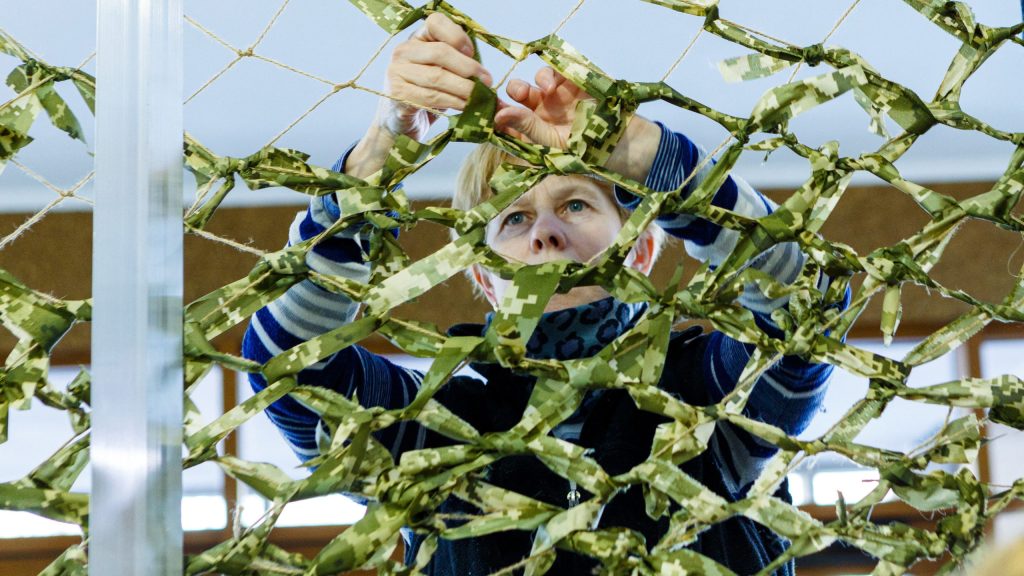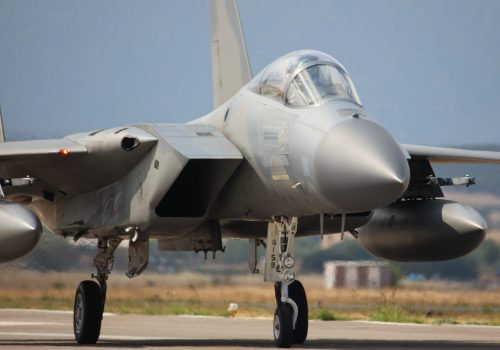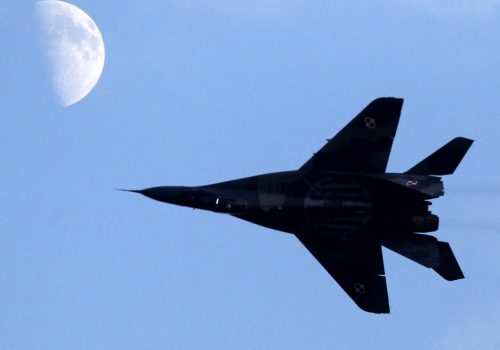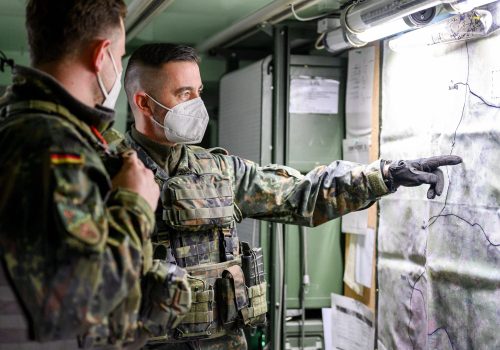As Russia’s military campaign in Ukraine grinds away, decimating cities and claiming more civilian lives each day, Western policymakers are grasping for ways to stop the killing. One of the major debates from Washington to Kyiv is whether the United States and NATO should impose a no-fly zone over Ukraine. In this series, Atlantic Council experts grapple with both sides of the controversial question, as well as offer other ways the West can help if, as seems likely at the moment, implementing a no-fly zone isn’t feasible. Below, Sarah Dawn Petrin and Marla Keenan propose other humanitarian interventions. Read Richard D. Hooker, Jr.’s argument in favor of a no-fly zone and Kelly Grieco’s case against one.
As Russia intensifies its war in Ukraine, threatening to encircle Kyiv and pounding civilians through punishing artillery strikes on numerous other cities, NATO allies have turned down pleas from President Volodymyr Zelenskyy to establish a no-fly zone over the country. Secretary General Jens Stoltenberg has made it clear: The Alliance believes securing the airspace over Ukraine would escalate the conflict and draw the Alliance into a broader war.
But there’s plenty NATO member states can still do to protect civilians on the ground short of shooting down Russian aircraft over the country (which would also prevent Ukrainian air assets and humanitarian flights from doing their jobs).
Preventing harm to civilians has been part of the Alliance’s mission since long before the 2016 Warsaw Summit, during which NATO adopted a Policy for the Protection of Civilians (PoC). Recognizing that previous missions in Kosovo and Libya were hampered by a lack of clear guidance on how to protect civilian populations, NATO’s Allied Command Operations (ACO) produced an operational handbook laying out four ways the Alliance can use its military power to ensure the safety of civilians: understanding the human environment, mitigating harm, facilitating access to basic needs, and contributing to a safe and secure environment.
Here’s how this can be done in Ukraine, which currently includes recognition of NATO standards on the protection of civilians as a mechanism for increasing interoperability between Ukrainian and NATO forces.
First, allied nations should help the country better understand the human environment by providing intelligence and analysis that looks specifically at the risks and threats civilians face. This must include assessing the vulnerabilities of the population by age and gender, in a recognition that men and women are affected by conflict differently. There are numerous reports and open-source documentation of Russian security forces intentionally targeting civilians in bread lines, apartment buildings, schools, and hospitals. Children who are losing out on education might suffer enduring psychological wounds. Many elderly and disabled persons are trapped and unable to leave their homes. Enabling government forces to have adequate communications systems to provide early warnings about threats of attack to all these groups can save lives.
By collecting information from multiple sources and ensuring that analysts are trained in threat and risk assessments, NATO can provide Ukrainian authorities with the analysis they need to anticipate, strategize, and triage threats to civilians. This information should then be shared in civil-military coordination meetings with humanitarian agencies that can respond to the rapidly changing situation on the ground and address gaps in access to basic needs such as shelter, electricity, food, and water.
The United Nations reports that more than three million Ukrainians have left their homes. Women and children are leaving loved ones behind as adult men under the age of sixty are required to be on alert for mobilization. The separation of families makes it more likely that refugees will face economic hardship, harassment, and sexual violence. Understanding the pattern of displacement and ensuring safe transportation routes is an important part of a human-environment analysis to inform an effective protection strategy. Meanwhile, civilians who cannot leave areas under siege—or are staying to fight—will need open lines of communication and adequate supplies to stay alive. Plans need to be made to care for the sick and the wounded, as well as mortuary services provided for the dead. Hospitals, ambulances, and humanitarian workers need safety guarantees to operate.
Second, mitigating harm means diminishing the capabilities of the attacker—in this case, that of Russia to target Ukraine from Belarus and the Black Sea. Neighboring countries must be repeatedly told through diplomatic messages that attacks on civilians and civilian infrastructure will have consequences. Documenting the types of weapons used against civilians, including their harmful effects, and violations of international humanitarian law can help ensure future accountability while also identifying current and future threats.
Mitigating harm also means recognizing both the cost and benefit of arming civilians. For example, what will happen to these weapons when the conflict ends? We know that to truly protect civilians, military hardware alone is not sufficient; assistance should include humanitarian supplies, communications and logistical support, and other materials that keep civilians safe (such as those to reinforce bomb shelters). In the near future, Ukraine will also need technical support to facilitate the repair of civilian infrastructure such as damaged buildings, bridges, lines of communication, and public utilities.
At the current stage of the conflict, facilitating access to basic needs includes supporting the establishment of humanitarian corridors so that civilians can safely evacuate from areas under attack. Working in collaboration with civil authorities to ensure that transportation routes to western Ukraine remain open will help displaced civilians find refuge in Poland, Romania, and elsewhere. This will be incredibly challenging in the current environment, in which Russia is allegedly violating agreements for safe passage. But listening to and providing support for local and international humanitarian agencies that can facilitate the logistics of moving people and position supplies in the right place will be key.
Fourth, if and when Russian troops withdraw, allied nations can support the restoration of a safe and secure environment. NATO should partner with the Ukrainian government to restore civil authority throughout the country. This could include an international training mission or other resources—both monetary and materiel—to support the security sector in maintaining public safety.
None of these protection measures requires a no-fly zone. To date, most of the military assistance provided to Ukraine has focused on countering Russia. But as the war drags on and immediate military requirements are met, that attention needs to shift to the sustainment of human needs, including support for humanitarian operations and the viability of public infrastructure—a task that is not often recognized as a priority for military planners.
What NATO needs to do now is to focus on operationalizing the protection policy and guidance it already has in place. This includes recognizing the non-military aspects of keeping people safe from harm. The only question is: Will it?
Sarah Dawn Petrin is a nonresident senior fellow with the Transatlantic Security Initiative in the Atlantic Council’s Scowcroft Center for Strategy and Security. She is also a former advisor to the US military and NATO on developing strategy, policy, and doctrine for the Protection of Civilians and Women, Peace, and Security and has worked with refugees in conflict zones for more than twenty years.
Marla Keenan, an adjunct senior fellow at the Stimson Center and a national security fellow at the Truman National Security Project, contributed to this article.
Further reading
Fri, Mar 18, 2022
A no-fly zone over Ukraine? The case for NATO doing it.
New Atlanticist By Richard D. Hooker, Jr.
The West stands at the crossroads. It's time to act by establishing a no-fly zone over Ukraine.
Fri, Mar 18, 2022
A no-fly zone over Ukraine? The case against NATO doing it.
New Atlanticist By Kelly A. Grieco
Intervening beyond providing weapons to Ukraine's military and food to the Ukrainian population would only make the nightmare worse.
Mon, Mar 7, 2022
A new era for NATO has begun
New Atlanticist By
On a political and on a military level, NATO is closer than ever—and readier than ever.
Image: A woman weaves a camouflage net at a reception point for humanitarian aid, in Uzhhorod, Ukraine, on March 12, 2022. Photo by Serhii Hudak/Ukrinform/ABACAPRESS.COM/REUTERS



